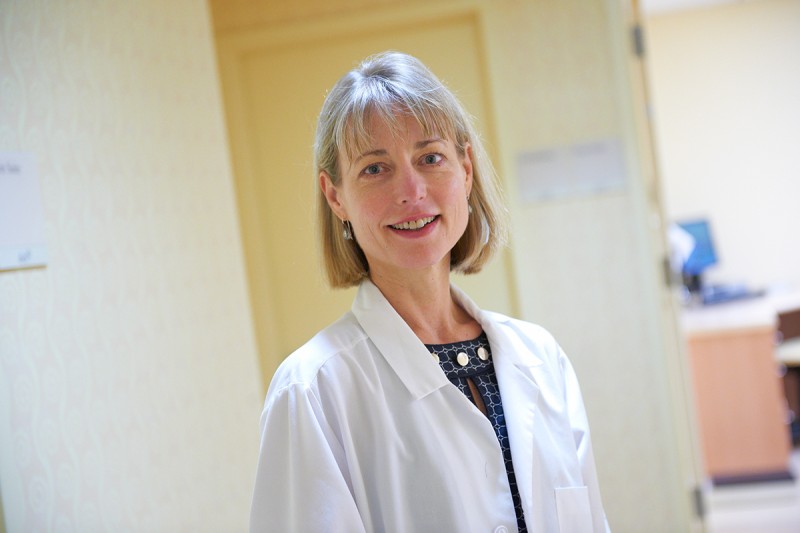
Uterine sarcomas are quite rare, accounting for less than 4% of uterine cancers, which grow in the uterus. About 1,200 women in the United States each year are diagnosed with a type of uterine sarcoma, which includes leiomyosarcoma.
Memorial Sloan Kettering medical oncologist Martee Hensley specializes in the diagnosis and treatment of uterine sarcomas and other gynecologic cancers. We spoke with her recently about the importance of a proper diagnosis and about how treatments are improving the lives of women living with this disease.
How do leiomyosarcomas and other uterine sarcomas differ from other types of uterine cancer?
Uterine sarcomas arise in the muscle or connective tissues of the uterus, whereas the more common type of uterine cancer, called endometrial carcinoma, starts in the lining of the uterus. These two types of cancer have different systems of staging and different treatment approaches. Some high-grade uterine sarcomas can be much harder to treat than endometrial carcinomas and have lower survival rates, even when the disease is caught early.
There are several different types of uterine sarcomas, which vary in their behavior, prognosis, and treatment. The most common type is leiomyosarcoma. Other types include carcinosarcoma, adenosarcoma, low-grade endometrial stromal sarcoma, and high-grade endometrial stromal sarcoma. In addition to being very different from endometrial carcinoma, these sarcoma types are very different from each other. Each has its own method of treatment. For example, some of these tumors may be hormone-sensitive whereas others are not.
Because these tumors can be difficult to diagnose correctly, and because their management strategies can be very complicated, it’s important that women who have them are treated at a center like MSK, which has extensive experience in diagnosing and treating them.
Could you explain more about why proper diagnosis is so important?
It’s vital to have pathologists who are experts in sarcoma review the pathology slides. At MSK we are fortunate to have those specialists. I work with them closely to understand the specific type of uterine sarcoma each of my patients has.
Our pathologists are experienced in recognizing the fine distinctions of every tumor. This gives us a better understanding of the potential behavior of each patient’s cancer, helps us estimate the risk that the tumor may come back after surgery, and helps us determine the optimal treatment strategy.
What are the symptoms of uterine sarcoma?
For all uterine cancers, not just sarcoma, symptoms may include abnormal bleeding or unusual discharge from the vagina between menstrual periods or after menopause. Other symptoms can include pain, an unusual feeling of fullness in the pelvic area, and frequent urination.
Are there any risk factors for leiomyosarcoma and other uterine sarcomas?
Uterine sarcomas are very rare diseases. Most women who develop these cancers do not have any identifiable risk factors for sarcoma. Women who are survivors of childhood cancers and who were treated with radiation are at increased risk for developing sarcomas as adults, including uterine sarcomas. But those women are a small minority of cases.
Most women who get this disease develop it in their early to mid-50s, but there is a broad range of ages at which they are diagnosed.
While leiomyosarcomas develop commonly in the muscle wall of the uterus, they can also develop in both men and women in other organs or tissues that have smooth muscle cells.
How is uterine sarcoma treated?
The most common treatment is surgery, especially when the disease is diagnosed at an early stage and has not spread beyond the pelvis. At a minimum, women need a hysterectomy — removal of the uterus — but may require more extensive surgery depending on how far the cancer has spread.
Uterine sarcoma can metastasize to other parts of the body, most commonly to the lungs. For women who develop metastatic disease, we consider a number of different approaches. If a patient has an isolated metastasis, like a single tumor in the lung or the liver, we can often remove it with surgery or treat it with an interventional radiology approach, such as ablation. The decision about the best approach is very nuanced. For that reason it’s important to consult with a doctor who has experience treating metastatic sarcomas.
For patients whose disease is more widespread, there are a number of different effective chemotherapy regimens that are good at controlling the disease. When one stops working, we usually have other options that we can try. MSK sarcoma physicians are leaders in the development of new treatment approaches for uterine sarcoma and other sarcomas.
What are some of the challenges of treating leiomyosarcoma and uterine sarcomas?
It may be difficult to know whether a uterine mass is a sarcoma or not. There are no diagnostic imaging techniques that can reliably distinguish between a uterine sarcoma and a benign uterine growth such as a leiomyoma [fibroid] or a low-grade pathology such as STUMP [smooth muscle tumor of uncertain malignant potential]. For this reason, it’s a good idea for women with abnormal uterine findings to consult with a gynecologic oncologist for proper planning of their surgery.
Why did you choose to work on uterine sarcomas at Memorial Sloan Kettering?
I feel privileged to care for women who are facing these rare and complex cancers. It is highly satisfying to help patients understand their disease each step of the way, and to help them make the best treatment choices. Doing this work at MSK means that I am fortunate to work with a deeply experienced team of sarcoma-dedicated specialists representing all aspects of care — pathologists, surgeons, radiation oncologists, medical oncologists, radiologists, and nurses. Our collective skills and experience in the diagnosis and treatment of these rare tumors give us the ability to choose the best treatment for each patient that fits the behavior of that patient’s specific sarcoma.




